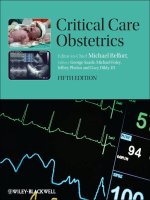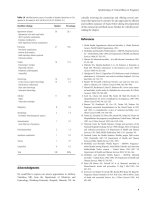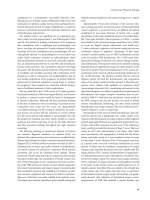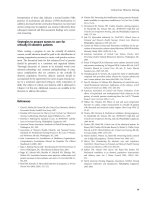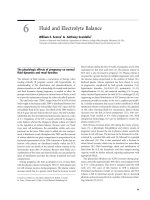Critical Care Obstetrics part 54 docx
Bạn đang xem bản rút gọn của tài liệu. Xem và tải ngay bản đầy đủ của tài liệu tại đây (189.82 KB, 10 trang )
Overdose, Poisoning and Envenomation During Pregnancy
519
Suspected overdose or
poisoning in pregnancy
Conscious
Unconscious
ABC
Consider trauma
Patent AWY
Spontaneous
breathing
Pulse
Altered mental
status
O
2
+ “coma cocktail”
(glucose, thiamine,
flumazenil, naloxone)
Response
No response
Repeat doses
No response
Intensive care consult
Toxicology consult
ICU admission
H&P
Monitor fetus
Toxicology samples
Suicide potential
evaluation
Altered mental status?
No
Yes
Positive drug ID
Negative drug ID
Supportive measures
*
I:
II:
III:
IV:
* May require restraints, sedation, and Foley catheterization
Decontamination
procedures
Specific antidote
• Observation/monitoring
until therapeutic goals
• Psychiatry clearance
Dismiss and F/U Admit
Improvement No improvement
V:
(a)
Figure 39.2 (a) Guidelines for evaluation and
management of pregnant patients with a known or
suspected toxic exposure. (b) Guidelines for the
evaluation of the unconscious pregnant patient with
a known or suspected toxic exposure. During 1999
1085 suicidal toxic exposures among pregnant
women were reported to American Poison Control
Centers. This represents 12% of the toxic exposures
reported during pregnancy for that year and less
than 1% of the suicide attempts by poisoning
reported to the American Association of Poison
Control Centers. The substances most frequently
involved were acetaminophen (alone or in
combination with decongestants and antihistamines;
35.5%), nonsteroidal anti - infl ammatory drugs
(15.2%), selective serotonin - reuptake inhibitors
(SSRIs; 8.8%), and benzodiazepines (7.1%).
* May require restraints, sedation, and Foley
catheterization. ACLS, advanced cardiac life support;
AWY, airway; CPR, cardiopulmonary resuscitation;
C/S, cesarean section; EKG, electrocardiogram; F/U,
follow - up; GA, gestational age; H & P, history and
physical; OD, overdose. Reproduced with permission
from Gei AF, Saade GR. Poisoning during pregnancy
and lactation. In: Yankowitz J, Niebyl J.
Drug
Therapy in Pregnancy
, 3rd edn. Philadelphia:
Lippincott, Williams and Wilkins, 2001.
• Some patients would require observation and management in
an intensive care setting (see Table 39.7 ).
Toxic i dentifi cation
• The collection of samples for toxicology is of paramount
importance in the identifi cation of the toxic agent(s) causing the
exposure, to predict the severity and to implement and monitor
specifi c treatment/antidotes. As a general rule, at least one
sample of all biologic fl uids should be obtained, and saved
for toxicology analysis (see Tables 39.8 and 39.9 ). Depending
on the clinical circumstances, these will include blood, urine,
saliva, vomit, gastric lavage fl uid, feces, cerebrospinal fl uid,
Chapter 39
520
Obstructed AWY
No spontaneous
breathing
No pulse
Establish patent AWY
Assisted ventilation
CPR
ACLS protocols
Stat consult with obstetrics/gynecology
Stable Unstable
Determine viability
Consider emergent C/S
Continue CPR/ACLS protocols
Determine GA/viability
Monitor: vitals/EKG/SaO
2
/fetus
H&P
Drug ID/OD mechanism
ICU admission
Response No response
Consider
perimortem C/S
A
B
C
I:
II:
III:
IV:
(b)
Figure 39.2
Continued
.
amniotic fl uid if collected, and meconium if the patient delivers
soon after admission. Occasionally the analysis of an arterial
blood gas and basic chemistry will detect an anion gap [AG=(N
a
+
+K
+
) − (Cl
−
+HCO
3
−
); normal outside pregnancy 12 ± 4 mEq/l;
for pregnancy 8.5 ± 2.9 mEq/l; postpartum 10.7 ± 2.5 mEq/l]
or osmolar gap (normal − 5 to +15 mOsm/l) which will assist
in the differential diagnosis of acidosis and suggest the possibility
of a poisoning or overdose (see Tables 39.10 and 39.11 )
[27,28,29] .
• The mainstay of treatment for all poisonings is supportive
therapy. For some toxic agents, three additional strategies can be
implemented to: (a) decrease the exposure ( decontamination pro-
cedures ), (b) enhance elimination (diuresis, hemofi ltration,
hemoperfusion, hemodyalisis, and plasmapheresis), or (c) coun-
teract the toxicity of the agent (antidotes). The specifi c measures
to enhance elimination and the use of antidotes are particular for
every toxic substance and will be discussed as appropriate in the
corresponding section (see Tables 39.12 , 39.13 , 39.14 , 39.15 and
39.16 ).
Decontamination p rocedures
Skin
Substances that can cause signifi cant systemic toxicity through
transdermal absorption include: organophosphate insecticides,
organochlorines, nitrates, and industrial aromatic hydrocarbons.
Organophosphates in particular can pass through intact skin at a
remarkable speed, without causing any specifi c skin sensation of
burning or itching. In theory, pregnancy, as shown in Table 39.2 ,
predisposes to such toxicity, given the physiologic increase in skin
perfusion throughout gestation.
Overdose, Poisoning and Envenomation During Pregnancy
521
salicylates, meprobamate, barbiturates, glutethimide, or drugs
that can delay the gastric emptying: tricyclics, narcotics, salicy-
lates, or conditions producing adynamic ileus (see Table 39.12 ).
Its use is controversial for the following reasons:
1 not immediately effective;
2 the effect may persist for 2 hours, delaying the administration
of adsorbants;
3 unlikely to be effective within several hours after the ingestion
(more than 1 – 2 hours with exceptions);
4 not proven to be better than lavage;
5 several contraindications: caustic ingestion; altered mental
status; inability to protect airway, seizures or seizure potential,
hemorrhagic diathesis, hematemesis, ingestion of drugs that can
lead to rapid change in the patient ’ s condition (tricyclics, β -
blockers, PCP, isoniazid);
6 has no value in ethanol intoxication and certain hydrocarbon
ingestions;
7 in case of failure to induce emesis (about 5% of cases), the
stomach should be evacuated by other means, since ipecac can be
cardiotoxic (theoretical risk).
Recently published guidelines recommend the use of ipecac
syrup when in the absence of contraindications (above) it can be
Table 39.3 Altered mental status: indications for antidote treatment in pregnancy.
Naloxone
(Narcan)
Altered mental status (AMS) associated with:
• miosis
• respiratory rate less than 12 or
• circumstantial evidence of opioid use/abuse
2 mg (IV, IM, ET, IL); onset of action: 1 – 3 min. May repeat if no response is
noted after 3 – 5 min (maximal effect is observed within 5 – 10 min)
• An IV drip or repeated doses are given as needed
• Higher doses may be necessary to reverse methadone, diphenoxylate,
propoxyphene, butorphanol, pentazocine, nalbuphine, designer drugs, or
veterinary tranquilizers
• Caution in cardiovascular disease; may precipitate withdrawal symptoms in
patients with opiate addiction
Thiamine (vitamin B
1
,
thiamilate)
AMS in patient with risk factors for B
1
defi ciency:
• ethanol abuse
• malnutrition
• hyperemesis gravidarum
• eating disorder
• total parenteral nutrition
• AIDS
• cancer
• dialysis requirement
100 mg daily IV/IM for up to 2 weeks
• Administer before or with dextrose - containing fl uids (100 mg/L of fl uid)
Flumazenil
(Romazicon)
AMS with:
• suspected or known benzodiazepine exposure and no
contraindication for antidote use (hypersensitivity, use of
benzodiazepine for control of life - threatening condition,
intracranial pressure or seizure disorder), coexposure to
tricyclic antidepressant or chronic benzodiazepine use
• check EKG to rule out conduction disturbances, which
would suggest the presence of tricyclics
0.2 mg (2 mL) given IV over 30 s; a second dose of
0.3 mg (3 mL) can be given over another 30 s
• Further doses of 0.5 mg (5 mL) can be given over 30 s at 1 - min intervals up to
a total dose of 3 mg (although some patients may require up to 5 mg)
• If the patient has not responded 5 min after receiving a cumulative dose of
5 mg, the major cause of sedation is probably not due to benzodiazepines and
additional doses of fl umazenil are likely to have no effect
• For resedation, repeated doses may be given at 20 - min intervals; no more
than 1 mg (given as 0.5 mg/min) at any one time and no more than 3 mg in
any 1 h should be administered
The skin should be fl ushed thoroughly with warm soapy water.
It may be worthwhile to use an industrial shower (as is used for
corrosive exposure) to thoroughly rinse the entire body. A rare
exception to immediate decontamination with water would be
the exposure to agents that may react violently with it (e.g. the
chemical may ignite, explode, or produce toxic fumes with water).
Examples include: chlorosulfonic acid, titanium tetrachloride,
and calcium oxide.
Gastrointestinal [30,31,32,33]
Several strategies can be useful, as described below.
Dilution
Lacking from alternatives (see below), 200 – 300 ml of milk may
be given orally (not through gastric tubes) in caustic ingestions
(acids or alkalis).
Emesis
Considered the second choice after lavage as the preferred method
for gastric emptying. The dose in adults is 30 ml of ipecac with
water and repeated in 15 – 30 minutes if vomiting is not induced.
Indicated in ingestions of drugs that can form gastric concretions:
Chapter 39
522
Class of drug Common signs Common causes
Anticholinergics Dementia with mumbling speech Antihistamines
Tachycardia Antiparkinsonian medications
Dry fl ushed skin Atropine
Dilated pupils (mydriasis) Scopolamine
Myoclonus Amantadine
Temperature slightly elevated Antipsychotics
Urinary retention Antidepressants
Decreased bowel sounds Antispasmodics
Seizures/dysrhythmias (severe cases) Mydriatics
Skeletal muscle relaxants
Some plants (i.e. jimson weed)
Sympathomimetics Delusions Cocaine
Paranoia Amphetamines
Tachycardia Methamphetamines and derivatives
Hypertension Over - the - counter decongestants
(phenylpropanolamine, ephedrine,
pseudoephedrine)
Hyperpyrexia
Diaphoresis
Piloerection NB: Caffeine and theophylline overdoses have
similar fi ndings, except for organic psychiatric
signs
Mydriasis
Hyperrefl exia
Seizures/dysrhythmias (severe cases)
Opiate/sedatives Coma Narcotics
Respiratory depression Barbiturates
Constricted pupils (miosis) Benzodiazepines
Hypotension Ethchlorvynol
Bradycardia Glutethimide
Hypothermia Methyprylon
Pulmonary edema Methaqualone
Decreased bowel sounds Meprobamate
Hyporefl exia
Needle marks
Cholinergics Confusion/CNS depression Organophosphate and carbamate insecticides
Weakness Physostigmine
Salivation Edrophonium
Lacrimation Some mushrooms (
Amanita muscaria
;
Amanita
pantherina
,
Inocybe
spp.,
Clitocybe
spp.) Urinary and fecal incontinence
Gastrointestinal cramping
Emesis
Diarrhea
Diaphoresis
Muscle fasciculations
Bronchospasm
(From Briggs GG, Freeman RK, eds. Drugs in pregnancy and lactation, 4th edn. Baltimore: Williams and Wilkins,
1994; and Doyon S, Roberts JR. Reappraisal of the “ coma cocktail ” . Dextrose, fl umazenil, naloxone and
thiamine.
Emerg Clin of N Am
, 1994;12:301 – 316.)
Table 39.4 The most common toxic syndromes.
Overdose, Poisoning and Envenomation During Pregnancy
523
Table 39.5 Physical fi ndings in poisoning.
Pupils
Dilation
Alkaloids
Aminophylline
Anticholinergics
Antihistaminics
Barbiturates
Carbon monoxide
Cocaine
Cyanide
Ergot
Ethanol
Ethylene glycol
Glutethimide
LSD
Methaqualone
Mushrooms
Phenothiazines
Phenytoin
Quinine
Reserpine
Sympathomimetics
Toluene
Tricyclics
Withdrawal states
Constriction
Acetone
Barbiturates
Benzodiazepines
Caffeine
Chloral hydrate
Cholinergics
Cholinesterase inhibitors
Clonidine
Codeine
Ethanol
Meprobamate
Opiates (except meperidine)
Organophosphates
Phencyclidine
Phenothiazines
Propoxyphene
Sympatholytics
Breath odor
Acetone: Acetone, chloroform, ethanol, isopropyl alcohol,
salicylates
Acrid or pear - like: Chloral hydrate, paraldehyde
Bitter almonds: Cyanide
Carrots: Cicutoxin (water hemlock)
Garlic: Arsenic, organophosphates, phosphorus,
selenium, thallium
Mothballs: Camphor, naphthalene, paradichlorobenzene
Pungent aromatic: Ethchlorvynol (Placidyl)
Violets: Turpentine
Wintergreen: Methyl salicylate
Refl exes
Depressed
Antidepressants
Barbiturates
Benzodiazepines
Chloral hydrate
Clonidine
Ethanol
Ethchlorvynol
Glutethimide
Meprobamate
Narcotics
Phenothiazines
Tricyclic antidepressants
Valproic acid
Hyperrefl exia
Amphetamines
Carbamazepine
Carbon monoxide
Cocaine
Cyanide
Haloperidol
Methaqualone
Phencyclidine
Phenothiazines
Phenytoin
Propoxyphene
Propranolol
Strychnine
Tricyclic antidepressants
(Data for “ Breath odor ” from Olson K. Poisoning and drug overdose, 2nd edn. Norwalk, CT: Appleton and Lange, 1994.)
administered within 30 – 90 minutes of an ingestion with a sub-
stantial risk of serious toxicity to the victim and no alternative to
decrease gastrointestinal (GI) absorption is available (or effective)
and a delay of greater than 1 hour to an emergency medical facil-
ity is anticipated [34] .
Gastric l avage
Indicated when emesis is inappropriate or contraindicated, the
patient is comatose or mentally altered, the substance ingested
has the potential for seizures or when the substance ingested is
lethal and/or rapidly absorbed (i.e. delay for emesis can result in
Chapter 39
524
Table 39.7 Quantitative toxicology testing.
Test Time to sample postingestion Repeat sample Implication positive test
Acetaminophen 4 h None Blood level
Nomogram and N - acetylcysteine
Carbamazepine 2 – 4 h 2 – 4 h Repetitive doses of activated charcoal/hemoperfusion
Carboxyhemoglobin Immediate 2 – 4 h 100% oxygen
Cholinesterase blood RBC Immediate 12 – 24 h Confi rm exposure to insecticide
Digoxin 2 – 4 h 2 – 4 h Digoxin antibody fragments (Fab)
Ethanol 0.5 – 1 h Not necessary If negative, not ethanol intoxication; if positive, inconclusive (tolerance)
Ethylene glycol 0.5 – 1 h 2 h Ethanol therapy, hemodialysis, sodium bicarbonate
Heavy metals First 24 h 2 – 4 h Chelation therapy, dialysis
Iron 2 – 4 h (chewable/liquid preparation
absorbed faster)
2 – 4 h
Serum iron 350 µ g use deferoxamine
Isopropanol 0.5 – 1 h 2 h Supportive - care hemodialysis
Lithium 2 – 4 h 4 h Hemodialysis
Methanol 0.5 – 1 h 2 h Ethanol therapy folinic acid, NaHCO
3
, hemodialysis
Methemoglobin Immediate 1 – 2 h Methylene blue
Phenobarbital 1 – 2 h 4 – 6 h Alkaline diuresis
Repeated activated charcoal; hemoperfusion
Phenytoin 1 – 2 h 4 – 6 h Supportive care
Repeated activated charcoal
Salicylates 2 – 4 h 2 – 4 h Serum and urine alkalinization
Repeated activated charcoal, hemodialysis
Theophylline 1 - h peak at 12 – 36 h 1 – 2 h Repeat activated charcoal, hemoperfusion
2 - PAM, pralidoxime; ABGs, arterial blood gases; Fab, fragment antigen - binding; PT, prothrombin time; PTT, partial thromboplastin time.
(Reproduced by permission from Mowry JB, Furbee RB, Chyka PA. Poisoning. In: Chernow B, Borater DC, Holaday JW, et al., eds. The Pharmacological Approach to the
Critically Ill Patient, 3rd edn. Baltimore: Williams and Wilkins, 1995.)
Supine hypotensive syndrome
Lower potential to resist acidosis in pregnancy
Need for preservation of a maternal
P
a
O
2
of at least 60 – 70 mmHg for fetal oxygenation
Increased maternal cardiac output and oxygen consumption
Increased renal clearance of antidotes and therapeutic drugs
Different “ normal ” values of blood tests such as BUN and creatinine
Effects of various resuscitative drugs on the uteroplacental circulation and myometrium
Increased potential for gastric aspiration in pregnant women and heightened need for airway protection
Table 39.6 Factors to consider in the clinical
management of the pregnant poison patient.
Drug Detectable after use
Alcohol 24 h
Amphetamines 48 h
Barbiturates
Short - acting 48 h
Long - acting 7 days
Benzodiazepines 72 h
Cocaine 72 h
Marijuana
Single use 72 h
Chronic use 30 days
(Reproduced by permission from Thorp J. Management of drug dependency, overdose, and withdrawal in the
obstetric patient.
Obstet Gynecol Clin N Am
1995;22:131 – 142).
Table 39.8 Time intervals for detecting drugs in
urine after use.
Overdose, Poisoning and Envenomation During Pregnancy
525
Acetaminophen Chloroquine Heptabarbital Procainamide
Amanita
toxins Creatinine Meprobamate Quinalbital
Ammonia Cyclobarbital Methaqualone Quinidine
Amobarbital Demeton Methotrexate Salicylates
Barbital Digoxin Methyprylon Secobarbital
Bromide Dimethoate Nitrostigmine Theophylline
Butabarbital Diquat Paraquat Thyroxine
Camphor Disopyramide Parathion Tricyclic antidepressant
Carbon tetrachloride Ethanol Pentobarbital Triiodothyronine
Carbamazepine Ethchlorvynol Phenobarbital Uric acid
Chloral hydrate Glutethimide Phenytoin
Table 39.9 Compounds for which hemoperfusion
is appropriate.
Acetaminophen Chloride Gallamine Nitrofurantoin
Aluminum Chromate Gentamicin Ouabain
Amanita
toxin Cimetidine Glutethimide Paraquat
Amikacin Cisplatin Hydrogen ions Penicillin
Ammonia Citrate Iodide Phenobarbital
Amobarbital Colistin Iron desferrioxamine Phosphate
Amoxicillin Creatinine Isoniazid Potassium
Amphetamines Cyclobarbital Isopropyl alcohol Primidone
Ampicillin Cyclophosphamide Kanamycin Procainamide
Aniline Cycloserine Lactate Quinidine
Arsenic Demeton Lead edetate Quinine
Azathioprine Diazoxide Lithium Salicylates
Barbital Dimethoate Magnesium Sodium
Borate Diquat Mannitol Streptomycin
Bromide Diisopyramide Meprobamate Strontium
Butabarbital Ethambutol Methanol Sulfonamides
Calcium Ethanol Methaqualone Theophylline
Camphor Ethchlorvynol Methotrexate Thiocyanate
Carbenicillin Ethionamide Methyldopa Ticarcillin
Carbon tetrachloride Ethylene glycol Methylprednisolone Tobramycin
Cephalosporins Flucytosine Methyprylon Trichloroethylene
Chloral hydrate Fluoride Metronidazole Urea
Chloramphenicol 5 - Fluorouracil MAO inhibitors Uric acid
Chlorate Fosfomycin Neomycin Water
Table 39.10 Compounds for which dialysis is an
appropriate consideration.
death). It is contraindicated in ingestion of caustics and in hem-
orrhagic diathesis. It has the advantages that can be performed
immediately on arrival of the patient; takes only 15 – 20 minutes
to complete and facilitates the administration of charcoal.
A large gastric tube (Ewald, Lavaculator
®
, and others) size
36 – 40 F should be passed orally with lubricant. Consideration
for intubation needs to be made in patients with depressed
mental status, altered gag refl ex, and seizures or seizure potential.
The patient needs to be placed in Trendelenburg or sitting posi-
tion and aspiration prior to lavage needs to be made to confi rm
placement of the tube (collect sample for analysis). Lavage is
made with normal saline or water in runs of 1.5 ml/kg (up to
200 ml) until clear and then with at least one more liter. Some
recommend slight movement changes of the patient or position
changes to dislodge potential residues of medications or undis-
olved pills.
Adsorption ( a ctivated c harcoal)
Activated charcoal is a fi nely divided powder made by pyrolysis
of carbonaceous material. It consists of small particles with an
internal network of pores that adsorb substances. It is indicated
after gastric emptying procedures (successful or not) and in
repeated doses (2 – 4 hours) for drugs with enterohepatic circula-
tion (theophylline, digoxin, nor and amitryptiline, salicylates,
benzodiazepines, phenytoin, and phenobarbital for example).
This effect has been called GI dialysis. Activated charcoal may be
used immediately after ipecac (does not interfere with its action;
some authors actually think this is the best way to give it) and
Chapter 39
526
Neutralizing a gents
In some poisonings a neutralizing agent instead of charcoal is
preferable for instillation (see Table 39.13 ).
Cathartics
Used as adjunctive treatment with charcoal. These agents should
be used only when indicated. They are contraindicated in diar-
rhea, dehydration, electrolyte imbalances, abdominal trauma,
intestinal obstruction and ileus. The agent most frequently used
in poisoning treatment is sorbitol because of the onset of action
N - acetylcysteine. It is contraindicated in caustic ingestions and
ineffective in ingestion of elemental metals (iron for example),
some pesticides (malathion, DDT), cyanide, ethanol, and
methanol.
The typical dose is 30 – 100 g in adults (or 1 g/kg) and is usually
given with a cathartic (50 ml of 70% sorbitol or 30 g of magne-
sium sulfate) in order to accelerate the transit time of the complex
toxin – charcoal. A superactivated charcoal formulation, capable
of adsorbing two to three times the conventional capacity of the
charcoal, is available.
Table 39.11 Antidotes.
Poison Antidote Dosage
Acetaminophen N - Acetylcysteine
140 mg/kg PO, followed by 70 mg/kg/4 h × 17 doses
Anticholinergics (atropine) Physostigmine salicylate 0.5 – 2.0 mg IV (IM) over 2 min every 30 – 60 min prn
Anticholinesterases
(organophosphates)
Atropine sulfate 1 – 5 mg IV (IM, SQ) every 15 min prn
Pralidoxime (2 - PAM) chloride
1 g IV (PO) over 15 – 30 min every 8 – 12 h × 3 doses prn
Benzodiazepines Flumazenil (British data) 1 – 2 mg IV (for respiratory arrest)
Carbon monoxide Oxygen 100%, hyperbaric
Cyanide Amyl nitrite Inhalation pearls for 15 – 30 s every minute
Sodium nitrite 300 mg (10 mL of 3% solution) IV over 3 min, repeated in half dosage in 2 h
if persistent toxicity
Sodium thiosulfate 12.5 g (50 mL of 25% solution) IV over 10 min, repeated in half dosage in 2 h
if persistent toxicity
Digoxin Antidigoxin Fab fragments —
Ethylene glycol Ethanol 0.6 g/kg ethanol in D5W IV (PO) over 30 – 45 min, followed initially by
110 mg/kg/hr to maintain blood level of 100 – 150 mg/dL
Extrapyramidal signs Diphenhydramine HCl 25 – 50 mg IV (IM, PO) prn
Benztropine mesylate 1 – 2 mg IV (IM, PO) prn
Heavy metals (arsenic, copper,
gold, lead, mercury)
Chelator
Calcium disodium edetate (EDTA) 1 g IV (IM) over 1 h every 12 h
Dimercaprol (BAL) 2.5 – 5.0 mg/kg IM every 4 – 6 h
Penicillamine 250 – 500 mg PO every 6 h
Heparin Protamine 1 mg/100 units heparin and for every 60 min after heparin, halved dose
Iron Desferrioxamine mesylate
1 gIM (IV at a rate of ≤ 15 mg/kg/hr if hypotension) every 8 h prn (maximum
80 mg/kg in 24 h)
Isoniazid Pyridoxine Gram per gram ingested; 5 g, if INH dose unknown
Magnesium sulfate Calcium glutamate 2 – 3 g IV over 5 min (in 30 - mL D10)
Methanol Ethanol See ethylene glycol
Methemoglobinemia (nitrites) Methylene blue 1 – 2 mg/kg (0.1 – 0.2 mL/kg 1% solution) IV over 5 min, repeated in 1 h prn
Opiates/narcotics Naloxone HCl 0.4 – 2.0 mg IV (IM, SQ, ET) prn
Warfarin Phytonadione/vitamin K 0.5 mg/min IV (in NS or D5W)
2 - PAM, pralidoxime; ET, endotracheal; IM, intramuscularly; INH, isoniazid; NS, normal saline; PO, by mouth; prn, as circumstances may require; SQ, subcutaneously.
(From Thorp J. Management of drug dependency, overdose, and withdrawal in the obstetric patient.
Obstet Gynecol Clin N Am
1995;22:222 – 228; and Roberts JM.
Pregnancy related hypertension. In: Creasy RK, Resnick R, eds. Maternal - fetal Medicine: Principles and Practice, 3rd edn. Philadelphia: WB Saunders, 1994:804 – 843.)
Overdose, Poisoning and Envenomation During Pregnancy
527
Table 39.12 Indications for ipecac syrup.
Gastric concretion formation
Salicylates
Meprobamate
Barbiturates
Glutethimide
Gastric emptying delay (pregnancy)
Tricyclics
Narcotics
Salicylates
Conditions producing adynamic ileus
Table 39.13 Poisoning in which a specifi c neutralizing agent is preferable to
activated charcoal.
Mercury Sodium formaldehyde (20 g) converts HgCl to
less soluble metallic mercury
Iron Iodium bicarbonate (200 – 300 mL) converts
ferrous iron to ferrous carbonate
Iodine Starch solution (75 g of starch in 1 L of water;
continue until aspirate is no longer blue)
Strychnine, nicotine, quinine,
physostigmine
Potassium permanganate (1:10 000)
Table 39.14 Substances most frequently involved in adult exposures ( > 19
years).
Substance No. % of all adult
exposures
As cause of
mortality
Analgesics 92 245 13.3 1
Sedatives/hypnotics/antipsychotics 67 946 9.8 3
Cleaning substances 66 384 9.5 12
Antidepressants 55 429 8.0 2
Bites/envenomations 55 145 7.9 19
Alcohols 37 451 5.4 6
Food products, food poisoning 35 860 5.2 20
Cosmetics and personal care
products
33 511 4.8 18
Chemicals 31 738 4.6 10
Pesticides 31 285 4.5 15
Cardiovascular drugs 28 941 4.2 5
Fumes/gases/vapors 27 486 3.9 9
Hydrocarbons 27 419 3.9 16
Antihistamines 19 570 2.8 11
Anticonvulsants 17 851 2.6 7
Antimicrobials 17 683 2.5 14
Stimulants and street drugs 17 423 2.5 4
Plants 17 261 2.5 17
Cough and cold preparations 16 866 2.4 18
(From Litovitz TL, Klein - Schwartz W, White S, et al. 2000. Annual report of the
American Association of Poison Control Centers Toxic Exposure Surveillance
System.
Am J Emerg Med
2001;19(5):337 – 95.)
Table 39.15 Stages of acetaminophen toxicity.
Phase Time Symptoms
I 0 – 24 h Gastrointestinal symptoms (anorexia, nausea, vomiting),
malaise, diaphoresis
II 24 – 48 h Clinical improvement, but abnormal liver function tests
III 72 – 96 h Peak hepatotoxicity with encephalopathy, coagulopathy,
and hypoglycemia
IV 7 – 8 days Death, or recovery from hepatic failure (begins within 5
days and usually progresses to complete resolution
within 3 months)
Table 39.16 Criteria for consideration of admission to the intensive care unit.
Mechanical ventilation required
Vasopressor support necessary
Arrhythmia management or need for hemodialysis
Signs of severe poisoning
Worsening signs of toxicity
Predisposing underlying medical conditions
Potential for prolonged absorption of toxin
Potential for delayed onset of toxicity
Invasive procedures or monitoring needed
Antidotes with potential for serious side effects
Suicidal patients requiring observation
(less than an hour), duration of effect (8 – 12 hours) and no inter-
action with charcoal. Oil cathartics are contraindicated because
they can be aspirated and can increase the absorption of hydro-
carbons. Complications can result from overaggressive use (fl uid
and electrolyte imbalances) [35] .
Whole - b owel i rrigation
Consists of the administration of polyethylene - glycol at a
rate of 500 – 2000 ml/hour orally or through a nasogastric
tube with the purpose of cleaning the bowel of whole or undis-
olved pills. May be helpful in clearing the GI tract of iron,
lead, zinc lithium, delayed - release formulations not adsorbed
by charcoal, very delayed onset of treatment or drug packets
of illicit drugs [36] . The procedure takes 3 – 5 hours and may be
complicated by bowel perforation or obstruction, ileus or GI
hemorrhage.
SPECIFIC AGENTS
More than 250 000 drugs and commercial products are available
for ingestion [37,38] . Table 39.14 lists the most frequent
causes of morbidity and mortality from poisoning in adults in the
USA [2] . Figure 39.3 details the classes of drugs most frequently
used in suicide attempts among 1085 pregnant women in 1999
[16] .
Chapter 39
528
Serum h alf - l ife
The serum half - life of acetaminophen in pregnancy is 3.7 hours,
and the pharmacokinetics (absorption, metabolism, and renal
clearance) are similar in the pregnant and nonpregnant states
[41,42] .
Lethal d osage
The lethal dosage is in excess of 150 mg/kg or 15 g in the healthy
adult and primarily involves hepatotoxicity [40,43] . The lethality
of acetaminophen is not only directly related to the dose, but to
other factors such as age, nutritional status, and other com-
pounds ingested. Renal failure, myocardial depression, and pan-
creatitis also have been observed in acute overdoses.
Maternal c onsiderations
In general, the primary short - term problem of acetaminophen
overdose is hepatocellular necrosis, which peaks at 72 – 96 hours.
Cardiac, renal, and pancreatic complications rarely occur, but
appropriate monitoring should be instituted. Perhaps the most
serious long - term consequence is residual liver damage.
Symptoms
Nausea; vomiting; anorexia; right upper quadrant pain. The
symptoms of acetaminophen toxicity have been divided into four
stages (Table 39.15 ).
Signs
Icterus; right upper quadrant abdominal tenderness; lethargy;
evidence of bleeding.
Diagnostic t ests
Blood: acetaminophen level (at 4 or more hours after ingestion);
transaminases (elevated); lactic dehydrogenase (LDH) (elevated);
prothrombin time (prolonged); amylase (elevated); lipase (ele-
The general characteristics and management of selected toxic
exposures during pregnancy are discussed in further detail in the
sections below, arranged in alphabetical order by drug name.
In the USA all consults and reports of exposure can be made
to the number: +1 - 800 - 222 - 1222.
Acetaminophen
Toxicology
• Common proprietary names: Alka - Seltzer ® (some presenta-
tions); Anacin ® ; Benadryl ® (some presentations); Comtrex ® ;
Contac ® ; Coricidin ® ; Darvocet; Dimetapp ® ; Drixoral ® ; Esgic ® ;
Excedrin (aspirin - free) ® ; Fioricet ® ; Goody ’ s Body Pain Relief ® ;
Lortab ® ; Midol ® ; Midrin ® ; Nyquil ® ; Pamprin ® ; Panadol ® ;
Parafon ® ; Percocet ® ; Phenaphen ® ; Robitussin ® ; Sudafed ® ;
Tavist ® ; Thera - Flu ® ; Triaminic ® ; Tylenol ® , Tempra ® ; Unisom ® ;
Vicodin ® ; Wygesic ®
• FDA classifi cation: B [39]
• As a cause of morbidity: 1 (other analgesics included) [2]
• As a cause of mortality: 1 (other analgesics included) [2]
• Most frequent route of exposure: ingestion
• Most frequent reason for exposure: unintentional overdose
Metabolism
Acetaminophen is metabolized in the liver to nontoxic sulfate
(52%) and glucuronide (42%) forms and then excreted by the
kidneys. Approximately 4% is metabolized by the hepatic cyto-
chrome oxidase P450 system, resulting in a toxic reactive inter-
mediate. This toxic metabolite is conjugated with glutathione and
excreted in the urine as nontoxic mercaptourate. Two percent of
acetaminophen is excreted unchanged. In an overdose, the
hepatic glutathione stores are depleted and the toxic intermedi-
ates become covalently bound to hepatic cellular proteins, result-
ing in hepatocellular necrosis [40] .
Acetaminophen
(alone or combination)
NSAIDs
SSRIs
Benzodiazepines
Miscellaneous
Substances most frequently involved
15.2
8.8
7.1
33.3
35.5
Figure 39.3 Suicide attempts during pregnancy by
poisoning or overdose: report from a National
Database, 1999 NSAIDs, nonsteroidal anti -
infl ammatory drugs; SSRIs, selective serotonin -
reuptake inhibitors.

